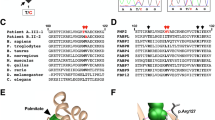Abstract.
Pelizaeus-Merzbacher disease (PMD) and the allelic spastic paraplegia type 2 (SPG2) arise from mutations in the X-linked gene encoding myelin proteolipid protein (PLP). Analysis of mutations affecting PLP, the major protein in central nervous system myelin, has revealed previously unsuspected roles for myelinating glia in maintaining the integrity of the nervous system. The disease spectrum for PMD and SPG2 is extraordinarily broad and can be best understood by accounting not only for the wide range of mutations that can occur but also for the effects of PLP1 mutations on both cell autonomous and non-cell autonomous processes in myelinating cells. Appreciating the wide range of genetic and cellular effects of PLP1 mutations is important for patient and family counseling, understanding disease pathogenesis, and, ultimately, for developing future disease-specific therapies.
Similar content being viewed by others
Author information
Authors and Affiliations
Corresponding author
Additional information
Received 24 April 2006; received after revision 3 July 2006; accepted 9 October 2006
Rights and permissions
About this article
Cite this article
Garbern, J.Y. Pelizaeus-Merzbacher disease: Genetic and cellular pathogenesis. Cell. Mol. Life Sci. 64, 50–65 (2007). https://doi.org/10.1007/s00018-006-6182-8
Published:
Issue Date:
DOI: https://doi.org/10.1007/s00018-006-6182-8




